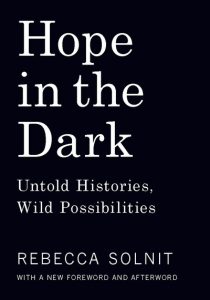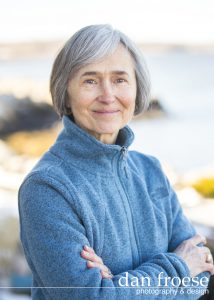Friday
UncategorizedHope in the Dark: Untold Histories, Wild Possibilities by Rebecca Solnit
 A review and reflection by Christine Heming
A review and reflection by Christine Heming
I recently had a conversation with my friend Irene about her activism: how to view activism from a buddhist perspective, how not to get caught in the “us verses them” narrative, and what guides her decisions about what to do and how to do it. As conversations often do, it got me thinking. It called to mind a favorite book of mine, Hope in the Dark. This is a book about activism. Solnit, a social and environmental activist, wants “to throw out the crippling assumptions that keep many from being a voice in the world.”
One of my favorite quotes in the book is from Eduardo Galeano, a committed leftist Uruguayan writer. Galeano describes his understanding of activism. He says it is not about reaching some final utopia but “Utopia is on the horizon. When I walk two steps, it takes two steps back. I walk ten steps, and it is ten steps further away. What is utopia for? It is for this, for walking.”
This always struck me as a metaphor for warriorship. It is how we create enlightened society. It’s the walking that matters – the path is the goal. When the Sakyong asked his father if society will ever become enlightened, his father replied, “That’s not really the point.” The Sakyong realized his question was rooted in doubt and that the real question was, “When is enlightened society not possible?”
Solnit suggests that striving for an imagined paradise as a static place, outside of history, or for perfection reached after struggle and strife, reduces activism to crisis management rather than everyday practice. The world, she says, is always being made and never finished. When we engage in activism with the expectation of a certain outcome, we are setting ourselves up to be discouraged, and we often loose heart and give up.
There’s a quote in Solnit’s book that addresses the kind of hope that fuels activism and keeps us walking. It comes from Vaclav Havel, the writer, dissident and statesman who was instrumental in toppling the grip of communism in Czechoslovakia in 1989. Havel said: “The kind of hope I often think about . . . [is] above all else a state of mind, not a state of the world. . . . It is an orientation of the spirit, an orientation of the heart; it transcends the world that is immediately experienced, and is anchored somewhere beyond its horizons. . . . [It is] an ability to work for something because it is good, not just because it stands a chance to succeed.”
Solnit agrees that activism is a matter of principle, a way to live. You “make yourself one small republic of unconquered spirit.” You do hope for results, of course, but you do not depend on them. You let go of the need for some final outcome or reassurance.
That’s the meaning of Solnit’s “hope in the dark.” The word “dark” is not referring to something ominous or foreboding, but is more a sense of the inscrutable or unknowable. Her use of the word comes from Virginia Wolf who wrote in her journal six months into the First World War: “The future is dark, which is on the whole, the best thing the future can be, I think.”
This kind of hope is the middle way through challenging and truly dark times. It is walking on the edge between what Solnit calls false hope and easy despair. It is the hope beyond what we usually think of as hope. It demands we take a broad perspective, are open to possibilities, and compelled to act. This is daringness, the activity of a warrior in the world.
Some of us (myself included) at times think being in the present moment means forgetting the past. Solnit warns this kind of amnesia can lead to despair. She reminds us that although hope is about the future, the grounds for hope lie in the recollections of the past, the “untold histories” of small acts that changed the world in surprising ways. Solnit encourages us to look back at the changes that we have witnessed even in our lifetime to recognize that people have power. As practitioners we are encouraged to reflect on the past, on how much we have overcome our egocentric patterns, on lessons learned, on the lineage and the examples of those who walked the path before us. Here we find inspiration to keep walking the path – the “wild possibilities.”
Solnit reminds us that social, cultural or political change is unpredictable. Even a month before the Berlin Wall fell, almost no one anticipated the sudden disintegration of the Soviet Bloc. “We don’t know what is going to happen, or how, or when, and that very uncertainty is the space of hope.”
One of the most intriguing references in Solnit’s book is the work of Jonathan Schell. Schell argues that the change that counts in revolution takes place first in the imagination. History often only picks up on change when the action starts. But real change arises out of the spread of ideas and the shaping of imaginations, which together give symbolic and cultural acts real political power. Schell writes: “Individual hearts and minds change; those who have been changed become aware of one another; still others are emboldened, in a contagion of boldness; the ‘impossible’ becomes possible . . . “
Many kinds of actions, some gradual and subtle, some dramatic and conflict-ridden, can impact our collective imagination. A revolution doesn’t necessarily look like revolution. “In other words, belief can be more effective than violence.”
Throughout the course of history the most fundamental changes are the hardest to track. We can never know exactly where our actions lead or how they impact others. Solnit presents many examples of what she calls the “indirectness of direct action.” The Vidyadhara Trungpa Rinpoche in giving instruction to new teachers was known to say, “No feedbags.” In other words, do your best but don’t expect kudos for giving an excellent talk. The reality is that you never know if your words fell on deaf ears or into open hearts.
When I asked Irene how she decides what informs her activism, she boiled it down to “it just felt right.” She follows her instinct and doesn’t get caught in logics or excuses that would sidetrack her from her intention. She is willing to make the walk (or march), to work for what is good, to hope in the dark.
Irene inspires me. I have just come through a period of despair fueled by the increasing evidence and serious talk of societal collapse as a result of climate disruption. My generation (I’m in my 70’s) for the most part has been impervious to the evidence; we simply went about our lives. The world needs people like Irene who challenge and motivate us to find our ground and begin walking
“We are all activists in some way or another, because our actions (or inactions) have impact.” We are the makers of the future. We are the creators of an enlightened society, which is always on the horizon, always possible. Let’s keep walking.
To find a copy of Hope in the Dark, visit Haymaker Books here.
Favorite Books Invitation
Here is an invitation to you, a reader of the Times, to let other readers know your non-dharma favorites – the books that have inspired, enlightened or enriched your life, recent or past. All you need to do is write a short paragraph or two about the book and what makes it a favorite. Send your favorites to [email protected] and be sure to write “My Favorite Book” in the subject line.
 Christine Heming is a writer and educator. She has been a student of the buddhadharma for over 45 years, and a senior teacher and meditation instructor in Shambhala. She lives in Port Royal, Nova Scotia.
Christine Heming is a writer and educator. She has been a student of the buddhadharma for over 45 years, and a senior teacher and meditation instructor in Shambhala. She lives in Port Royal, Nova Scotia.





Jan 29, 2020
Reply
Thank you, this answers the questions that I fell asleep with. I had been talking at length with a fellow campaigner on getting Lisa Savage, a Green Party candidate for the U.S. Senate from Maine, a kindergarten teacher, peace activist and labor union activist. I told him I would see what percolated up in my subconscious while I slept, when what I should have said is that I will put it out to the universe. I was looking for ideas for actions that would inspire people to gather signatures to put her on the ballot. Hope in the Dark gives a great framework to inspire our campaign as spiritual warriors.